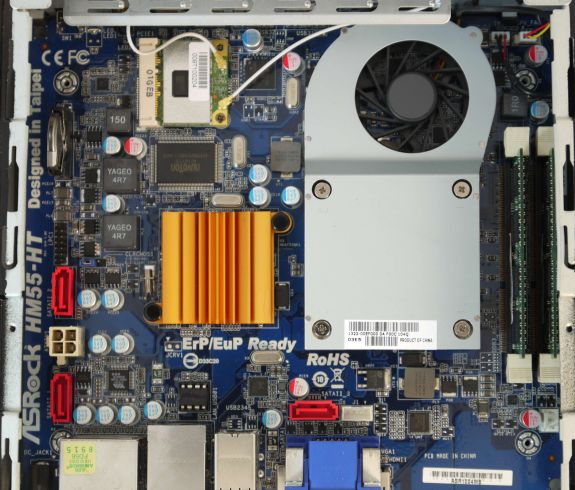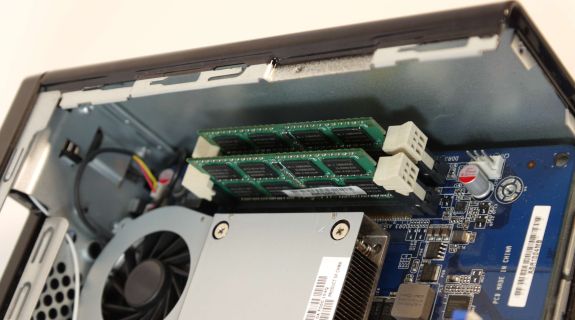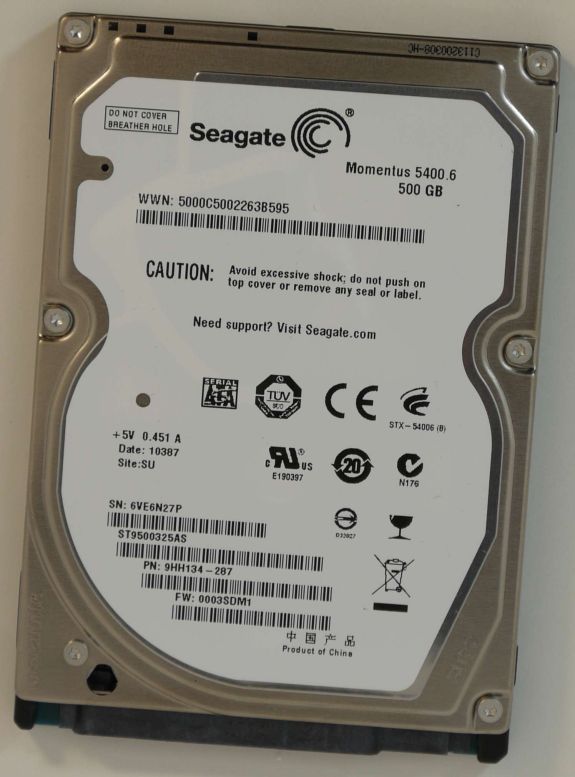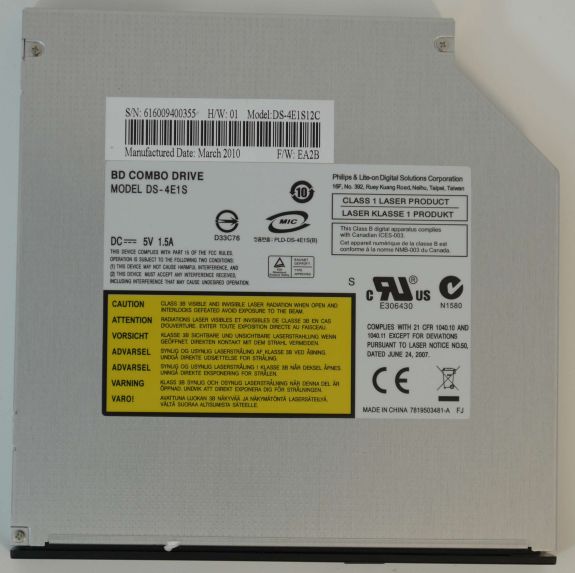ASRock Core 100HT-BD : Bringing HTPCs to the Mainstream Market [UPDATED : Noise Issue]
by Ganesh T S on July 19, 2010 9:34 PM EST- Posted in
- Home Theater
- Arrandale
- ASRock
- Media Streamer
- Core i3
- HTPC
Analyzing the system specifications reveals one clear advantage for ASRock. It is not going to be possible for the average HTPC enthusiast to build a similar system himself with off-the-shelf components. The reason lies in the fact that the Arrandale processor used in the system is currently available for OEM purchase only. All the processors available for general purpose (the Clarkdales) do not fit in the same power envelop as the Arrandales. We covered the Arrandale platform in detail earlier, and concluded that it had a very good power consumption / performance balance. In this section, we will analyze each of the system components in detail.
Motherboard & Chipset: mini-ITX Mobile Intel H55 Express
Over the last 6 months, we have seen many motherboards featuring the H55 chipset. In the mini-ITX form factor, we have covered Zotac's offering as well as Gigabyte's. However, both of them are meant for the desktop Clarkdale processors. What we see in the Core 100 HT-BD is more similar to the motherboards one sees in notebooks. Feature wise, the ASRock motherboard can be compared with the Gigabyte version, since both have support for USB 3.0 ports. However, being a mobile platform, there are some important differences. Tagging on USB 3.0 ports to the HM55 chipset is fraught with issues (more on this in the Performance section). Also, there is no PCI-E x16 slot in the motherboard because the chipset doesn't support it. DVI and PS2 ports are also absent. However, compared to the Gigabyte board, we have two extra USB 2.0 ports. The odd thing to observe here is that ASRock has decided to go with a VGA port instead of DVI, and providing us with a HDMI to DVI adapter, instead of providing a DVI port with a DVI to VGA adapter for folks with older equipment.
Rounding up the other components of the motherboard, we have the Realtek RTL8111E for GbE, and the VIA VT2020 for audio. The mini PCI-E expansion slot is occupied by the Atheros AR9287 module capable of 300 Mbps. As can be seen from the photograph, we have wires connected to the side panels, which act as antennae for the wireless signals. Like many other offerings in the market, ASRock also uses NEC's USB3 controller, giving the system two USB 3.0 ports. Another interesting chip on the board is the Nuvoton NCT6775F. It handles all the sensors (fan speed, temperature etc.) and also the IR support for the MCE remote.
The H55M chipset supports upto 4 SATA ports. In the Core 100 HT-BD, two of them are used by the Blu Ray drive and the hard disk. One of them is free for use by an optional 2nd hard drive (or SSD). The last one is made available as an eSATA port on the back panel. The mini-PCIE slot, as already mentioned, is taken up by the wireless module. In essence, the Core 100-HT BD's motherboard is a notebook motherboard in the mini-ITX form factor.
The Gigabyte mini-ITX (based on the H55) with the USB 3.0 ports can be purchased from Newegg currently for around $100. Since ASRock's version is based on the mobile version of the chipset, and also has a THX certified audio codec chip, the cost is bound to be slightly higher. One must also take into consideration the cost of the Atheros AR9287, which can be bought for around US $15 online. For the purpose of cost analysis, let us assume that one may theoretically be able to purchase a similar motherboard for US $140.
CPU & GPU: Intel Core i3-330M @ 2.13 GHz, iGPU @ 667 MHz
For the form factor and thermal design of the Core 100 HT-BD, only processors with a maximum TDP of 35W are supported. Also, most HTPCs do not require features like Turbo Boost, particularly when their performance exceeds what people have come to expect out of a particular form factor (talking about the Atom nettops) by a magnitude. Keeping in mind the cost of the processors and the nett cost of the system, ASRock has decided to go with the lowest end of the Arrandale spectrum, namely, the Core i3-330M. We feel that this is a very good choice, as the processor is powerful enought for most of today's demanding tasks, particularly from a HTPC perspective.
The integrated GPU is clocked at 600 MHz by default in the system, but it can be easily overclocked to 900 MHz without much effect on fan noise or any concerns about the system heating up. Most HTPC users are more interested in turning down the heat and power consumption. Towards this, attempts are made to undervolt or underclock the CPU. In our opinion, for the Core 100 HT-BD, the savings obtained through these methods are not worth the trouble. Intel's SpeedStep technology is enabled on this system, and we observed that the cores would clock around 940 MHz when doing light browsing tasks, and kick upto 2.14 GHz under heavy load. It is easy to overclock the system too (from within Windows, as well as the BIOS), but the need would probably be never felt in a HTPC usage scenario.
The pricing of the Core i3-330M is available only to OEMs. Our sources, however, informed us that it costs around US $135 in high volume.
DRAM: Elixir Memory's 2 x 2GB Nanya DDR3 @ 1066 MHz
The Core 100 HT-BD has two DDR3 slots, both of which are occupied by the 2 GB Nanya DIMMs. One can potentially use 4 GB DIMMs to get 8GB of system memory, but that would be an overkill from the HTPC perspective. ASRock's choice of 4GB is more than enough for the HTPC.
The 2 DIMMs can be bought currently for around $100 in total from resellers in the US.
Hard Disk: Seagate Momentus 2.5" 5400 rpm 500 GB
Since the form factor of the build indicates that the system is more of a notebook, the hard drive inside is a 2.5" model. ASRock has gone in with the Seagate Momentus 5400 rpm drive. While one might prefer a faster drive for installing the OS, there is no doubt that the lower power consumption of this unit makes it an ideal choice for the HTPC. There is enough space inside the system for an additional 2.5" drive, and filling that up with a SSD would be a great choice for the boot drive. The shipped Seagate drive is ideal and capacious enough for HTPC duties.
The hard drive can be currently had from Newegg for US $65.
Optical Disk Drive: Philips / Lite-On Blu-Ray / DVD RW
The Core 100 HT-BD model ships with the Lite-On DS-4E1S Blu-Ray / DVD RW drive. Again, this is a model meant for notebooks, with the tray not coming out fully when ejected. It can be found online for around $90 without shipping charges taken into consideration.
Miscellaneous Components
The chassis is obviously custom made for this motherboard. ASRock also throws in the SATA, power cables and screws for the optional 2nd hard drive. Mini-ITX cases with PSUs of much higher rating (the unit comes with an external 90W adapter) can be had for around US $50. So, we estimate the cost of the chassis, power adapter and other similar accessories to be around the same. Note that the unit also ships with an IR based MCE remote. Though the build quality of the remote is not high end in nature, we estimate that it adds around $30 to the cost.
Cost Analysis
| ASRock Core 100HT-BD Pricing Analysis | ||||
| Component | Average Price Online | |||
| Motherboard (with mini-PCIe wireless) | $140 | |||
| CPU | $135 | |||
| DRAM | $100 | |||
| HDD | $65 | |||
| Optical Drive | $90 | |||
| MCE Remote & IR Receiver | $30 | |||
| Misc Components (Chassis, Power Adapter, Cables, etc...) | $50 | |||
| Total Cost to Build | $610 | |||
| ASRock Core 100HT-BD Estimated Cost | $700 | |||
Newegg is supposed to have this HTPC for sale soon around the $700 price point. (The model with the DVD drive instead of the Blu-Ray is already on sale for $650.) With only a $90 premium over a home built HTPC, this is not a bad investment from the value viewpoint. Do note that the cost of the OS and keyboard / mouse have to be added on to this to get a sense of the true cost of the system. Also, we still have to take a look at the unit from various other perspectives. Read on to find out more.














107 Comments
View All Comments
spddemon - Thursday, July 22, 2010 - link
That is great news ganeshts.34.5db at 2ft is very quiet to me... with my theater setup you can not even hear my xbox so this would be no problem.
i still want to see the core i3 330 vs 530 tests. I wonder how much faster the 530 is since it is a faster CPU and GPU, but I also wonder how much more power it will consume in typical home theater use.
omems - Thursday, July 22, 2010 - link
This is a really great article, Ganesh. My HTPC is getting a bit old at about 6 years, so I'm definitely ready to upgrade and take advantage of some of the newer technologies which are finally being combined usefully. I have a few questions about how this assembly sleeps:1. When you put it to sleep, which components remain on? Just RAM? Any fans?
2. I believe the Atheros AR9287 supports what they call wake-on-wireless. Does that work in this implementation, from sleep? How about from hibernation?
3. Did you try coming out of Hibernation and seeing if the handshakes were maintained?
4. I am confused by what's going on when you say in the Ease of Use section:
"...ASRock supplies an Instant Boot utility. Using this, whenver [sic] the Core 100 HT-BD is shut down, it boots up once again and shuts down before the power can be safely removed."
Does the instant boot utility bring the machine into the main OS (say Windows) or is it a stripped-down linux environment for simple access to things like music and DVD playback?
If it's the former, what's the point--what does it do that just waking up doesn't? Or is it some kind of middleware to keep maybe the IR and WiFi active?
If it's the latter, what sorts of playback support is there?
I'm mostly concerned with limiting hard drive and power usage, but also being able to quickly resume from a wireless connection. With my current setup (almost 7 years old at its core), I like to send it to Hibernate, and then wake it up via WOL with my iPod or another computer to send new files to over. I avoid sleep because the something (CPU fan and hard drives, if I recall correctly) is still active and it's kind of loud and I worry the drives will wear out faster. I probably could sort it out but why bother when such cool new toys are coming out?
Thanks!
ganeshts - Thursday, July 22, 2010 - link
omems,I will try to handle your queries in a series of replies. In this one, I will let you know things which I know off the top of my head without accessing the unit:
1. Sleep : The fans are completely off. I heard nary a sound from the unit when in sleep mode. I think cross ventilation slots on either side of the RAM modules help. The blue front LED keeps blinking slowly on and off in sleep mode, but you can turn that OFF in the BIOS by Enabling the 'Goodnight LED' option (see BIOS pictures set).
2. Wake on wireless using AR9287 hasn't been tested. I will get back to you on this ASAP.
3. Handshakes are maintained much better than in my ATI based HTPC. My power on sequence when unit is in sleep or hibernate or complete shutdown mode (as long as AC adapater is connected to unit) is as follows: Power on TV and put it it in AV receiver input mode -> Power on Receiver -> Press Power button on MCE remote. Display comes out perfectly on TV every time I followed this sequence.
4. InstantBoot : Look at the coverage on ZDNet here: http://www.zdnet.com/blog/hardware/asrock-4-second... ; I think their explanation and analysis would be much better than what I can do in this space :)
Will provide more info within a day or so.
ganeshts - Thursday, July 22, 2010 - link
omems,ASRock reports that only the AR9280 and AR9281 support Wake-On-Wireless. Unfortunately, the add on card in Core 100 is the AR9287.
I am not sure how you wanted to use the 'wake on wireless' feature, but I would say that using the MCE remote to wake up the unit is the easiest and most simple.
omems - Monday, July 26, 2010 - link
Thanks, Ganesh, for all the additional info.I plan to use the wake on wireless when the HTPC is asleep and I'm at another computer in the house and want to move newly-acquired media to the HTPC without having to go to that room and wake it up.
I suppose it's not a deal breaker though if the included card doesn't support it. I could use encouragement to get off my butt now and again.
The insantBoot sounds like an interesting hybrid concept. Thanks for the link.
Cheers
ganeshts - Monday, July 26, 2010 - link
omems, I did see an option in the BIOS to enable / disable 'Wake-On-LAN'. So, if this unit is going to be connected to a wired network, you might still find it hard to get off your couch / chair / bed :Dvlado08 - Thursday, July 22, 2010 - link
Ganesh on page 5 you say:"We did observe red spikes, but disabling the C-states, as well as SpeedStep in the BIOS Advanced CPU configuration helped in alleviating the issue."
On page 11 you say:
"At idle, the system consumed around 18 W."
1) Is this DC power or is this AC power measured at wall outlet?
2) Is 18W idle power with enabled C-states and SpeedStep?
3) And if yes then what is the idle power when disabling the C-states, as well as SpeedStep?
ganeshts - Thursday, July 22, 2010 - link
vlad08,The quoted power numbers are measured AC power using Kill-a-Watt over a 6 hour usage period.
18W idle power is with C-state and SpeedStep enabled. I will quote idle power numbers with them disabled after testing out tonight.
ganeshts - Friday, July 23, 2010 - link
vlado08,The idle power consumption with both C-states and SpeedStep disabled is 21.6W.
The CPU wasn't overclocked (it idled at 2.14 GHz).
Regards
Ganesh
vlado08 - Friday, July 23, 2010 - link
Thanks Ganesh.So it is still less than the ion 330 idle power - 28,6W according to:
http://www.anandtech.com/show/2828/8
If only Intel team resolve the 23,976hz issue .....
I am still waiting because for me this is more important than bitsreaming